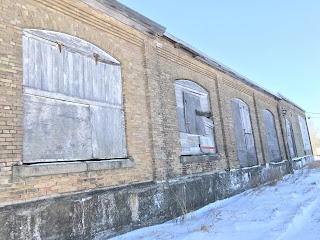Have you ever wondered about the inner workings of the roundhouse? How on earth did they turn a locomotive engine around? Here is a short video from Henry Ford's Innovation Nation that shows it nicely. This one remains as on of three standing roundhouses in Manitoba, the other two being in The Pas and Dauphin. Gordon Goldsborough featured the roundhouse on his CBC radio spot called Abandoned Manitoba and you can listen to it here. It was named Manitoba Municipal Heritage Site #142 in 1996.
 In 1939 and for the next 3 decades, the building was used by Colin C. Campbell & Son as a seed and fertilizer warehouse and seed cleaning operation. Colin came to Reston in 1901 with horses to sell as he had been a horse drover in Ontario. His sister Kate was married to Reston merchant G.S. Munro and his McMurchy cousins also had put down roots here. Colin C. married Minnie McLandress in 1902. Besides running a livery barn, he was a grain buyer for James Richardson. During the 1930's, Colin saw the need for planting grasses and clover to hold the soil and he began marketing seed all over Canada and the United States. Needing more room, he purchased the Roundhouse and installed seed cleaning equipment and developed a large retail and mail order business. He employed between 4 and 12 people on a 24 hour basis, more during the winter months and early spring. He diversified by operating a cattle feed lot in the acres around the roundhouse. Colin C. Campbell & Son closed in 1969 when more farmers had their own seed cleaning equipment and pedigree seed was more widely available. It was bought to be used for storage by Jim Walker and then later the Martin brothers.
In 1939 and for the next 3 decades, the building was used by Colin C. Campbell & Son as a seed and fertilizer warehouse and seed cleaning operation. Colin came to Reston in 1901 with horses to sell as he had been a horse drover in Ontario. His sister Kate was married to Reston merchant G.S. Munro and his McMurchy cousins also had put down roots here. Colin C. married Minnie McLandress in 1902. Besides running a livery barn, he was a grain buyer for James Richardson. During the 1930's, Colin saw the need for planting grasses and clover to hold the soil and he began marketing seed all over Canada and the United States. Needing more room, he purchased the Roundhouse and installed seed cleaning equipment and developed a large retail and mail order business. He employed between 4 and 12 people on a 24 hour basis, more during the winter months and early spring. He diversified by operating a cattle feed lot in the acres around the roundhouse. Colin C. Campbell & Son closed in 1969 when more farmers had their own seed cleaning equipment and pedigree seed was more widely available. It was bought to be used for storage by Jim Walker and then later the Martin brothers.
Ancestry user Grigg_Family14 has graciously agreed to allow me to use the picture below of the Campbell family. Colin C. is her great grandfather and the picture was taken in about 1950 in front of Colin C.'s former home. This beautiful home is now the Sauvé residence and was the first one featured in this blog here with a post written by Fletch Manning in 2004. Colin Sr.(1872-1959) and Minnie (1886-1957) had three children. A daughter Helen died in infancy and second daughter Mildred Jean married Frank Mellor and lived in the east. Their son Colin St Clair Campbell (1907-1989) took over the seed business and married the doctor's daughter Clair Clark (1917-1980) in 1939. They had 4 children and moved to B.C. in the 1970's. The Campbells are buried in Reston Cemetery.
 |
| Colin C. and his wife Minnie (McLaundress) are standing in the middle of the group of four and Colin S. and his wife Clair (Clark) Campbell are on the ends.  Have you ever heard of a ghost sign? Wikipedia says it is an old hand-painted advertising sign that has been preserved on a building for an extended period of time. The sign may be kept for its nostalgic appeal, or simply indifference by the owner. The Colin C. Campbell & Son ghost sign is a landmark in Reston and especially amazing to think it is on the north wall of the roundhouse and has been exposed to the harsh elements for so many decades. I hope it remains for decades more to connect us to our past. |




No comments:
Post a Comment